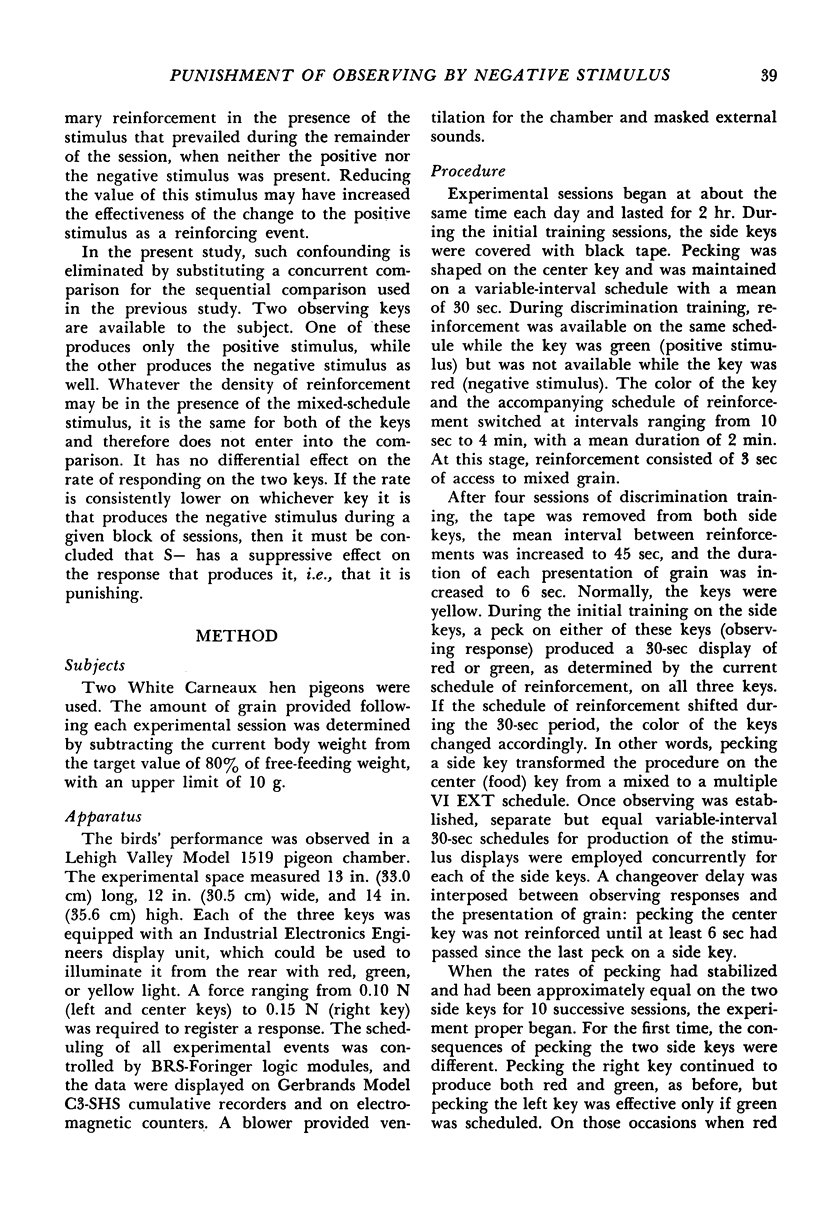Abstract
To determine the effect of a negative discriminative stimulus on the response producing it, two pigeons were each studied in a three-key conditioning chamber. During alternating periods of unpredictable duration, pecking the center (food) key either was reinforced with grain on a variable-interval schedule or was never reinforced. On equal but independent variable-interval schedules, pecking either of the side (observing) keys changed the color of all keys for 30 sec from yellow to either green or red. When the schedule on the center key was variable-interval reinforcement, the color was green (positive discriminative stimulus); when no reinforcements were scheduled, the color was red (negative discriminative stimulus). Since pecking the side keys did not affect grain deliveries, changes in the rate of pecking could not be ascribed to changes in the frequency of primary reinforcement. In subsequent sessions, red was withheld as one of the possible consequences of pecking a given side key. When red was omitted, the rate on that key increased, and when red was restored, the rate decreased. It was concluded that red illumination of the keys, the negative discriminative stimulus, had a suppressive effect on the response that produced it.
Full text
PDF







Selected References
These references are in PubMed. This may not be the complete list of references from this article.
- APPEL J. B. Aversive aspects of a schedule of positive reinforcement. J Exp Anal Behav. 1963 Jul;6:423–428. doi: 10.1901/jeab.1963.6-423. [DOI] [PMC free article] [PubMed] [Google Scholar]
- AZRIN N. H. Time-out from positive reinforcement. Science. 1961 Feb 10;133(3450):382–383. doi: 10.1126/science.133.3450.382. [DOI] [PubMed] [Google Scholar]
- BERLYNE D. E. Uncertainty and conflict: a point of contact between information-theory and behavior-theory concepts. Psychol Rev. 1957 Nov;64, Part 1(6):329–339. doi: 10.1037/h0041135. [DOI] [PubMed] [Google Scholar]
- Dinsmoor J. A., Browne M. P., Lawrence C. E. A test of the negative discriminative stimulus as a reinforcer of observing. J Exp Anal Behav. 1972 Jul;18(1):79–85. doi: 10.1901/jeab.1972.18-79. [DOI] [PMC free article] [PubMed] [Google Scholar]
- Jenkins H. M., Boakes R. A. Observing stimulus sources that signal food or no food. J Exp Anal Behav. 1973 Sep;20(2):197–207. doi: 10.1901/jeab.1973.20-197. [DOI] [PMC free article] [PubMed] [Google Scholar]
- Kaufman A., Baron A. Suppression of behavior by timeout punishment when suppression results in loss of positive reinforcement. J Exp Anal Behav. 1968 Sep;11(5):595–607. doi: 10.1901/jeab.1968.11-595. [DOI] [PMC free article] [PubMed] [Google Scholar]
- Kendall S. B. Some effects of response-dependent clock stimuli in a fixed-interval schedule. J Exp Anal Behav. 1972 Mar;17(2):161–168. doi: 10.1901/jeab.1972.17-161. [DOI] [PMC free article] [PubMed] [Google Scholar]
- Leitenberg H. Is time-out from positive reinforcement an aversive event? A review of the experimental evidence. Psychol Bull. 1965 Dec;64(6):428–441. doi: 10.1037/h0022657. [DOI] [PubMed] [Google Scholar]
- Rilling M., Askew H. R., Ahlskog J. E., Kramer T. J. Aversive properties of the negative stimulus in a successive discrimination. J Exp Anal Behav. 1969 Nov;12(6):917–932. doi: 10.1901/jeab.1969.12-917. [DOI] [PMC free article] [PubMed] [Google Scholar]
- THOMPSON D. M. ESCAPE FROM SD ASSOCIATED WITH FIXED-RATIO REINFORCEMENT. J Exp Anal Behav. 1964 Jan;7:1–8. doi: 10.1901/jeab.1964.7-1. [DOI] [PMC free article] [PubMed] [Google Scholar]
- THOMPSON D. M. PUNISHMENT BY SD ASSOCIATED WITH FIXED-RATIO REINFORCEMENT. J Exp Anal Behav. 1965 May;8:189–194. doi: 10.1901/jeab.1965.8-189. [DOI] [PMC free article] [PubMed] [Google Scholar]
- Wilton R. N., Clements R. O. The role of information in the emission of observing responses: a test of two hypotheses. J Exp Anal Behav. 1971 Sep;16(2):161–166. doi: 10.1901/jeab.1971.16-161. [DOI] [PMC free article] [PubMed] [Google Scholar]


